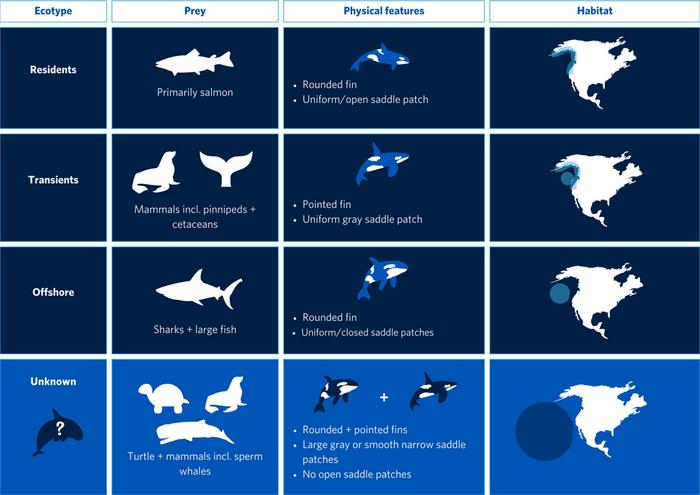Marine biologists are trying to make sense of a set of 49 killer whales whose physical characteristics are a mix of those normally associated with separate populations. They have been seen attacking sperm whales, a northern elephant seal, and a turtle, while also carrying the marks of frequent duels with sharks. There’s a reason Orcinus orca have been lumped with the popular name they have – but it looks like even among killer whales, this group is fearless.
“The open ocean is the largest habitat on our planet and observations of killer whales in the high seas are rare,” said first author of the new study on the population, University of British Columbia masters student Josh McInnes, in a statement. Consequently, McInnes and colleagues were intrigued by reports of the whales well off the coast of California and Oregon. That interest grew the more information they found on them.
Orcas are distinguished by the fact that different populations have highly varied diets and behaviors. Some live on fish, but others go for bigger (but rarer) marine mammal prey. Off America’s west coast, some are considered “residents”, sticking to the same territory, while others are classified as “transients” or “offshores”.
Although the population in question has been seen since 1997, encounters with humans – at least that have been reported – have been rare. McInnes and co-authors have put together nine reports that appear to be of the same group. These come from fishers and whale-watching tourists as well as researchers, made between 15 and 370 kilometers (10-220 miles) offshore.
Orcas that live closer to shore get seen often enough to become very familiar. Without such reports, McInnes and coauthors needed to be sure that reports over that time related to the same population. They were surprised to find traits normally associated with different population types together in the one group.
“While the sizes and shapes of the dorsal fins and saddle patches are similar to transient and offshore ecotypes, the shape of their fins varied, from pointed like transients to rounded like offshore killer whales,” said McInnes. “Their saddle patch patterns also differed, with some having large uniformly gray saddle patches and others having smooth narrow saddle patches similar to those seen in killer whales in tropical regions.”
A comparison of known killer whale lifestyles and the newly described population.
Image Credit: University of British Columbia
If such a mixed population was found among humans, one might conclude they were outcasts from different societies, coming together as outlaws to make the badlands their own. Too much anthropomorphizing can be dangerous, but observations suggest something similar.
McInnes stressed to IFLScience this is not a new species, as some media outlets have reported.
“In one of the first encounters researchers had with a pod of these oceanic killer whales, they were observed taking on a herd of nine adult female sperm whales, eventually making off with one. It is the first time killer whales have been reported to attack sperm whales on the west coast,” McInnes said. “Other encounters include an attack on a pygmy sperm whale, predation on a northern elephant seal and Risso’s dolphin, and what appeared to be a post-meal lull after scavenging a leatherback turtle.”
Taking on larger whales such as humpbacks can be dangerous enough for orcas, but sperm whales are likely to be tougher again. There’s a reason Moby Dick was not written about a blue whale – sperm whales are not as big as some of their baleen counterparts, but they’re much fiercer. It was sperm whales that may have worked out how to fight back against whalers, and shared the information around.
Nevertheless, it is clear from the reports that it was the orcas who had the upper flipper.
“The sperm whales were in a rosette formation,” the authors write. “Small concentrated groups of four to five killer whales randomly targeted and attacked individual sperm whales in the rosette […] rushing in and lunging at the sperm whales or striking them from below. Fresh blood and an oil slick of animal fat could be seen at the surface following each attack. Multiple sperm whales had extensive injuries […] One of the sperm whales was killed and dragged away from the rosette with several killer whales seen feeding on the carcass. The remaining sperm whales were believed to all have been seriously or mortally injured.”
On the other hand, five days later, an attack was foiled – additional sperm whales arrived to relieve a vulnerable group, and the orcas retreated.
Nevertheless, these killer whales are not the only tough guys in the sea. All but three of the 49 carry the marks of bites from cookiecutter sharks. Since cookiecutters favor tropical waters, the frequency of the bites indicates that the orcas probably spend a lot of time in deep waters further south.
Maybe they should team up with Starboard, the orca recently seen consuming a great white on its own, although there is the small matter of an ocean and continent between them.
“We hypothesize that these killer whales may represent a distinct oceanic subpopulation of transient killer whales or an undescribed oceanic population that feeds on marine mammals and sea turtles in the open ocean beyond the continental shelf break,” McInnes and co-authors write.
Hopefully further observations will reveal more.
The study is published in the journal Aquatic Mammals.
Source Link: Mysterious Shark-Bitten Orcas Feeding On Sperm Whales Don’t Fit Any Known Categories
